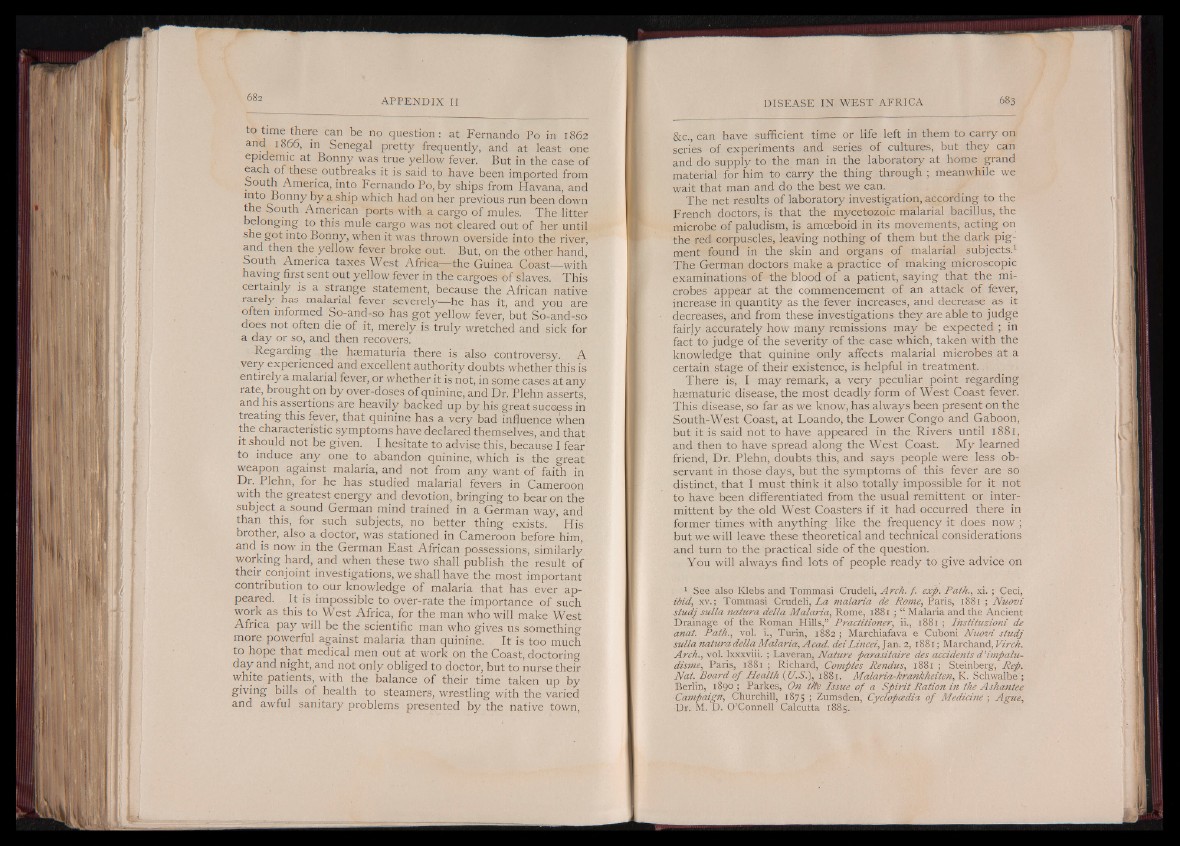
to time there can be no question: at Fernando Po in 1862
and 1866, in Senegal pretty frequently, and at least one
epidemic at Bonny was true yellow fever. But in the case of
each of these outbreaks it is said to have been imported from
South America, into Fernando Po, by ships from Havana, and
into Bonny by a ship which had on her previous run been down
the South American ports with a cargo of mules. The litter
belonging to this mule cargo was not cleared out of her until
she got into Bonny, when it was thrown overside into the river,
and then the yellow fever broke out. But, on the other hand,
South America taxes West Africa— the Guinea Coast— with
having first sent out yellow fever in the cargoes of slaves. This
certainly is a strange statement, because the African native
rarely has malarial fever severely— he has it, and you are
often informed So-and-so has got yellow fever, but So-and-so
does not often die of it, merely is truly wretched and sick for
a day or so, and then recovers.
Regarding the hsematuria there is also controversy. A
very experienced and excellent authority doubts whether this is
entirely a malarial fever, or whether it is not, in some cases at any
rate, brought on by over-doses of quinine, and Dr. Plehn asserts,
and his assertions are heavily backed up by his great s u c g o s s in
treating this fever, that quinine has a very bad influence when
the characteristic symptoms have declared themselves, and that
it should not be given. I hesitate to advise this, because I fear
to induce any one to abandon quinine, which is the great
weapon against malaria, and not from any want of faith in
Dr. Plehn, for he has studied malarial fevers in Cameroon
with the greatest energy and devotion, bringing to bear on the
subject a sound German mind trained in a German way, and
than this, for such subjects, no better thing exists. ’ His
brother, also a doctor, was stationed in Cameroon before him,
and is now in the German East African possessions, similarly
working hard, and when these two shall publish the result of
their conjoint investigations, we shall have the most important
contribution to our knowledge of malaria that has ever appeared.
It is impossible to over-rate the importance of such
work as this to West Africa, for the man who will make West
Africa pay will be the scientific man who gives us something
more powerful against malaria than quinine. It is too much
to hope that medical men out at work on the Coast, doctoring
day and night, and not only obliged to doctor, but to nurse their
white patients, with the balance of their time taken up by
giving bills of health to steamers, wrestling with the varied
and awful sanitary problems presented by the native town,
&c., can have sufficient time or life left in them to carry on
series of experiments and series of cultures, but they can
and do supply to the man in the laboratory at home grand
material for him to carry the thing through ; meanwhile we
wait that man and do the best we can.
The net results of laboratory investigation, according to the
French doctors, is that the mycetozoic malarial bacillus, the
microbe of paludism, is amoeboid in its movements, acting on
the red corpuscles, leaving nothing of them but the dark pigment
found in the skin and organs of malarial subjects.1
The German doctors make a practice of making microscopic
examinations of the blood of a patient, saying that the microbes
appear at the commencement of an attack of fever,
increase in quantity as the fever increases, and decrease as it
decreases, and from these investigations they are able to judge
fairly accurately how many remissions may be expected ; in
fact to judge of the severity of the case which, taken with the
knowledge that quinine only affects malarial microbes at a
certain stage of their existence, is helpful in treatment.
There is, I may remark, a very peculiar point regarding
haematuric disease, the most deadly form of West Coast fever.
This disease, so far as we know, has always been present on the
South-West Coast, at Loando, the Lower Congo and Gaboon,
but it is said not to have appeared in the Rivers until 1881,
and then to have spread along the West Coast. My learned
friend, Dr. Plehn, doubts this, and says people were less observant
in those days, but the symptoms of this fever are so
distinct, that I must think it also totally impossible for it not
to have been differentiated from the usual remittent or intermittent
by the old West Coasters if it had occurred there in
former times with anything like the frequency it does now ;
but we will leave these theoretical and technical considerations
and turn to the practical side of the question.
You will always find lots of people ready to give advice on
1 See also Klebs and Tommasi Crudeli, Arch. f. exp. Path., xi. ; Ceci,
ibid, xv.; Tommasi Crudeli, La malaria de Rome, Paris, 1881 ; Nuovi
studj sulla natura della Malaria, Rome, 1881 ; “ Malaria and the Ancient
Drainage of the Roman Hills,” Practitioner, ii., 1881 ; Ihstituzioni de
anat. Path., vol. i., Turin, 1882 ; Marchiafava e Cuboni Nuovi studj
sulla natura della Malaria, Acad, deiLincei, Jan. 2, 1881; Marchand, Virch.
Arch., vol. lxxxviii. ; Laveran, Nature -parasitaire des accidents d'impalu-
disme, Paris, 1881 ; Richard, Comptes Rendus, 1881 ; Steinberg, Rep.
Nat. Board o f Health (U.S.), 1881. Malaria-krankheiten, K. Schwalbe ;
Berlin, 1890 ; Parkes, On tlte Issue o f a Spirit Ration in the Ashantee
Campaign, Churchill, 18.75 » Zumsden, Cyclopaedia of Medicine ; Ague
Dr. M. D. O’Connell Calcutta 1885.